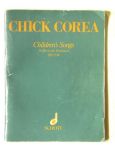Children's songs by Chick Corea as produced by Quakvartet
Some people ask: “Are we going to some sort of children's concert? Some new compositions for children?” Whenever I can, I try to explain: this is children's music in about to the same extent as “Alice in the Wonderland” by Caroll Lewis is children's literature. Youngsters and adults enjoy reading them alike, don't they. They appreciate its simplicity, playfulness, sense for nonsense, but in particular – they return to the almost forgotten territory of a child's soul that they rediscover by way of words and paper.
 The series of twenty “Children's Songs” is a spectacular composition among the works of the world famed jazz piano player and composer Chick Corea (1941). He wrote them within a period of nine years (1971-80) at the time of finding his “electric” expression that became part of the trends of American jazz with the advent of jazz rock, having been inspired by Miles Davis at the turn of the 60ies and 70ies. These musical miniatures, written originally for Fender Rhodes piano (1-15) and acoustic piano (16-20), are characterised by their special musical logic and, along with rising serial numbers, by increasing difficulty. The easy looking piano parts attract also beginning piano players, but only considerably mature musicians can master them due to the demanding rhythms and brilliant technique they require.
The series of twenty “Children's Songs” is a spectacular composition among the works of the world famed jazz piano player and composer Chick Corea (1941). He wrote them within a period of nine years (1971-80) at the time of finding his “electric” expression that became part of the trends of American jazz with the advent of jazz rock, having been inspired by Miles Davis at the turn of the 60ies and 70ies. These musical miniatures, written originally for Fender Rhodes piano (1-15) and acoustic piano (16-20), are characterised by their special musical logic and, along with rising serial numbers, by increasing difficulty. The easy looking piano parts attract also beginning piano players, but only considerably mature musicians can master them due to the demanding rhythms and brilliant technique they require.
Although Corea's main program consisted in jazz compositions with Latin American inspirations, also his electric piano, in a harder constellation, was now and then replaced by an acoustic piano, let alone in the lyrical intermezzos. Actually, his two LP Piano Improvisations (1971, ECM) show him as master of lyrics, his technique being fully in the service of his poetically tinged expression.
His come backs to lyrics are his topic also in his Lyric Suite for Sextet recorded in Los Angeles in September 1982 with the following set: piano (Chick Corea), vibraphone (Gary Burton) and string quartet Ikhwan Bae, Carol Sive – violin, Karen Dreyfus – viola, Fred Sherry – cello. These are just a few examples of Corea's poetics that is seen to permeate his jazz route, fostering his creative diversification. Chick Corea has often performed Children's Songs as part of his jazz concerts (e.g., as mentioned by musical publicist Jan Beránek in the booklet accompanying the CD QUAKVARTETO CHILDREN¨S SONGS, in the Polish town Zabrze in 1980) and recorded them on the acoustic piano in 1984 (Chick Corea – Children's Songs, 1984, ECM).
In his introduction to the score edition (Schott, ED 7254) the author remarks that any of the songs can be played on various instruments, as well as using various forms of orchestration. In his essay PLAY closing his album Chick Corea communicates his idea how a musician should perceive a PLAY, and not necessarily only the play of children's songs...Quakvartet has its own way to convey the lyrics and the playfulness of Children's Songs, and in this orchestration and arrangement, again, the resulting music is difficult to classify as to genre, chamber music with the spirit of play that does not avoid improvisation. Is it jazz? Is it classical music? Or world music?
Let the distinguished listeners consider themselves.....
Quotation from an interview with Martin Kumžák
..among others Composer, arranger, piano player and member of Milan Svoboda KONTRABAND. The interview was conducted by Ilja Kuèera jun. for the journal MUZIKUS (November 2002)
“Meanwhile I managed to learn from MELODIE that there is a certain Chick Corea. (This may have been the article by Jiří Černý: To What Infinity Does Chick Corea Return — Melodie 1976, N.5, p.149, However, this is a hypothesis of Dorothea Kellerova)
I went to the municipal library to lend a record of his. I just fell in love with that music. There were jazz rock records of a band and Children's Songs in-between. I was sort of upset by them. And when Milan Svoboda returned from America and brought the scores of these Children's Songs with him, I had them photocopied immediately and started to train them, and Chick Corea has been my absolute model ever since.”
